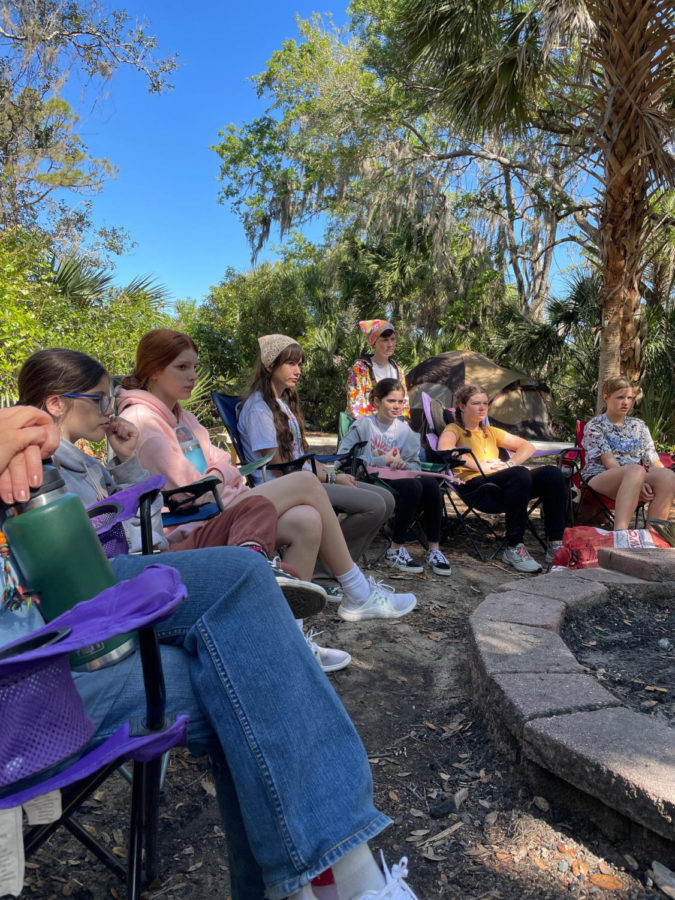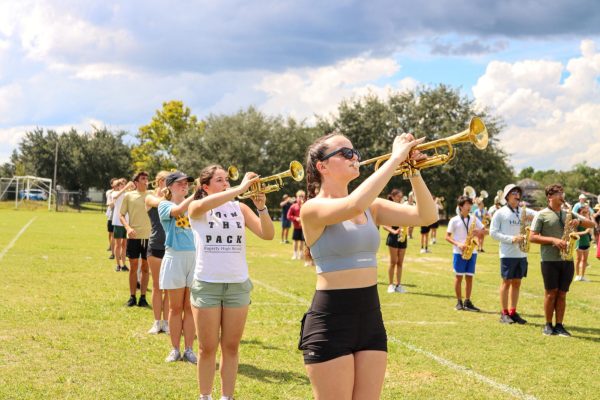Hagerty’s Latter-day Saints ask for acceptance
photo by Annavon Mattinson
Bohan and other Latter-day Saints sit outside and talk at girls’ camp in March. Bohan says that events like these help young girls better themselves.
We all have prejudices.
Walking into the Church of Jesus Christ of Latter-day Saints last Sunday, I was nervous. Born and raised a nondenominational Christian, I heard my fair share of things about it—mostly negative—and I wasn’t sure what to expect.
But its members were not wearing turtlenecks and floor-length skirts. They were not shouting that a sip of coffee will land you in Hell. They were not urging everyone to move to Utah. And they were not practicing polygamy.
Dressed in typical Sunday Best clothing, they were preaching about Jesus. They were giving testimonies that the church is true. They were urging people to put their trust in God. They were speaking about the importance of love.
They are people, too.
Latter-day Saints, more commonly known as “Mormons,” are members of the Church of Jesus Christ of Latter-day Saints. A Christian denomination that has, at times, fought to be recognized by other denominations, Latter-day Saints believe that Jesus Christ is the son of God and the Savior of the world, with the four main tenets of gospel being faith, repentance, baptism and the gift of the Holy Ghost. They study the Old and New Testaments of the Bible, along with the Book of Mormon, in which American prophets testified of Jesus Christ.
Similar to many other religions, Latter-day Saints are taught to avoid alcohol, tobacco, addictive drugs, explicit language and degrading media, like pornography. They practice abstinence out of wedlock and complete fidelity in marriage. Additionally, they are encouraged to wear modest clothing, but still have freedom in their fashion choices.
While a large portion of Latter-day Saints live in states like Utah and Idaho, there are congregations all over the country—including Oviedo. Roughly 20 Latter-day Saints attend Hagerty, including senior Grace White. Born into the Church, White is passionate about her faith and believes that it has shaped her into a better person.
“I strive to [make] the right [choices] in my everyday actions,” White said. “I know I have been protected and blessed by following my morals and would be a totally different person without them.”
Latter-day Saints attend a Church service every Sunday based on their ward, which is determined by where they live in the Central Florida area. Those who live in Tuskawilla go at 9:30 a.m., Oviedo at 11 a.m. and Chuluota at 12:30 p.m. Each service consists of an hour-long Sacrament Meeting and an hour of gospel study, or Sunday School, where Church members are divided into groups based on their age. In the Sacrament Meeting, Latter-day Saints partake in the sacrament, which is similar to the Holy Communion of other Christian faiths, sing Christian hymns and hear from speakers on a variety of gospel topics.
An even bigger time commitment, students attend Early Morning Seminary each weekday from 5:45 to 6:45 a.m. This is not entirely a religious event—rather, it is more like a history class. Students analyze scripture through reading, object lessons, games and videos. They receive class credit based on attendance, completion of assignments and end-of-semester assessments, similar to a typical high school or college course. Early Morning Seminary volunteer teacher Kerry Tait says that this daily event benefits students by teaching them the core doctrinal principles of their faith, discipline and keeping commitments.
“It’s very hard to get up early and attend something voluntarily. It takes faith, perseverance, and grit to develop this habit,” Tait said. “These traits carry over into many other areas of life and lead to the future success of these youth as they pursue education, employment and future family relationships.”
The Church also holds a number of casual events for members to attend. Each Wednesday, there is an activity night for children and teens where they can hang out, relax and play games. In the past, groups have gone rock-climbing, roller skating or even just held a pizza party. Latter-day Saints are also able to go to camps throughout the year in various locations, ranging from an aquarium to a member’s backyard. Freshman Brooke Bohan says that her favorite memories of the Church come from camp.
“It was really good to just be surrounded by people with the same morals as me,” Bohan said. “That’s really what it’s all about—bettering yourself and learning from each other.”
As children in the Church get older, they have the opportunity to be put into different quorums, which is considered a sacred privilege. For example, when boys reach the age of 16, they can be ordained into the priest quorum if they have been baptized and confirmed. As priests, they are able to baptize others, administer the sacrament and preach the gospel. John* was recently ordained into this quorum and feels that it has allowed him to build lasting friendships.
“I am grateful to be surrounded by some of my best friends and share these experiences and opportunities with them,” John said.
After graduating high school, many members of the Church work to spread their faith by going on mission trips. Both White and Jane* will be going on volunteer missions in the near future, in which they are assigned to a location by the Church. Though they are not yet sure where they will go, they are excited to share their beliefs with other parts of the world.
“My strong faith and testimony has led me to this decision,” White said. “I look forward to it and know that it’s the right thing to do.”
Although many good things come with being a Latter-day Saint, there are a number of misunderstandings about the religion, like the practice of polygamy. According to the Church’s website, a small number of Latter-day Saints had multiple wives—prior to the late 1800s. They believe that today, the Lord commands monogamy, and any groups that do not practice such are not members of the Church.
On top of that, many think that Latter-day Saints are held to strict rules that, if broken, can come with intense consequences. While they do try to practice the main tenets of the religion in full, many standards, such as caffeine consumption, are not written in stone.
“It is not as strict as people think it is,” White said. “Everything is up to the individual and their personal standards.”
When picturing a Latter-day Saint, most do not see a fun-loving, “normal” person. Often confused with the old-fashioned Amish, some assume that Church members do not dance, use electricity or wear typical clothes, but none of this is true. Bohan says that people have been both surprised and confused upon learning of her religion, as she dresses and acts like other teen girls.
“I think they think of super restricted people that are just boring and bland, you know?” Bohan said. “And it’s not that. You can still have fun and be part of that religion.”
But the misconceptions are not merely annoying rumors. The term “Mormon” alone has a negative connotation and has caused many Latter-day Saints to be questioned or even bullied. Jane has been mistreated because of her religion at school, to the point of feeling unwanted in clubs and losing friends. Even so, she has remained strong in her faith.
“There is really nothing I can do about that except turn the other cheek and forgive as Jesus taught,” Jane said. “Sure, these experiences weren’t the best, but I continue to believe because I choose to.”
Jane encourages those who are curious about the religion to ask questions to members of the Church directly, as discussing different beliefs can create more acceptance among different groups. Blindly accepting what others say can be harmful.
“We’re just doing our best to live the way we’ve been taught,” Jane said. “If someone adheres to their beliefs and they are genuine in their intent, that should always be respected.”
*Names changed for privacy
Your donation will support the student journalists of Hagerty High School. We are an ad-free publication, and your contribution helps us publish six issues of the BluePrint and cover our annual website hosting costs. Thank you so much!








